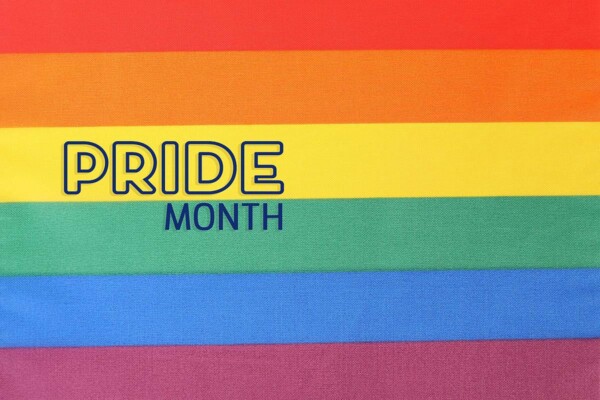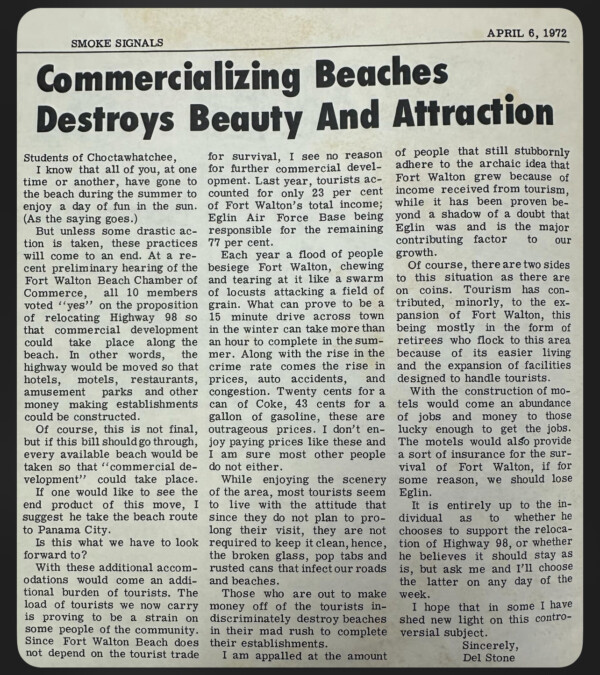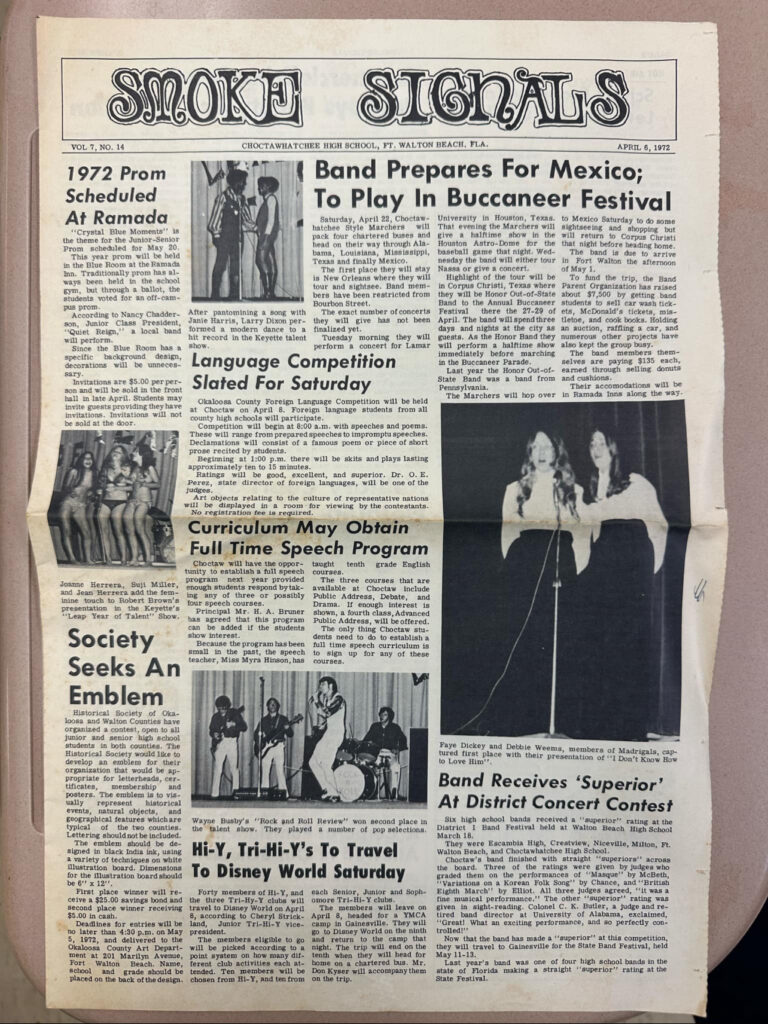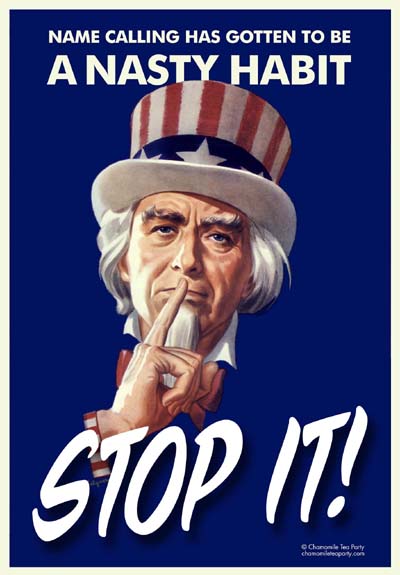VIDEO: If you don’t support your gay and trans kids, you’re a shitty parent

Image by Jernej Furman. CC license.
I found this online. I thought it was good. I’m posting it here, on the first day of Pride Month 2025:
—
My son is 15.
I never bought him a Pride onesie when he was a baby.
I never read him a book that had two moms as part of the storyline.
When he was little, stores didn’t have Pride displays or celebrate Pride Month.
He was raised Catholic and went to church.
Guess what? He’s gay.
The rainbow won’t make your kids gay. They’re born that way.
A display in a store won’t make your kid trans. They’re born that way.
If you don’t love and accept them for who they are, YOU are a shitty parent.
They haven’t failed.
You have.
About the author:
Del Stone Jr. is a professional fiction writer. He is known primarily for his work in the contemporary dark fiction field, but has also published science fiction and contemporary fantasy. Stone’s stories, poetry and scripts have appeared in publications such as Amazing Stories, Eldritch Tales, and Bantam-Spectra’s Full Spectrum. His short fiction has been published in The Year’s Best Horror Stories XXII; Alfred Hitchcock’s Mystery Magazine; the Pocket Books anthology More Phobias; the Barnes & Noble anthologies 100 Wicked Little Witch Stories, Horrors! 365 Scary Stories, and 100 Astounding Little Alien Stories; the HWA anthology Psychos; and other short fiction venues, like Blood Muse, Live Without a Net, Zombiesque and Sex Macabre. Stone’s comic book debut was in the Clive Barker series of books, Hellraiser, published by Marvel/Epic and reprinted in The Best of Hellraiser anthology. He has also published stories in Penthouse Comix, and worked with artist Dave Dorman on many projects, including the illustrated novella “Roadkill,” a short story for the Andrew Vachss anthology Underground from Dark Horse, an ashcan titled “December” for Hero Illustrated, and several of Dorman’s Wasted Lands novellas and comics, such as Rail from Image and “The Uninvited.” Stone’s novel, Dead Heat, won the 1996 International Horror Guild’s award for best first novel and was a runner-up for the Bram Stoker Award. Stone has also been a finalist for the IHG award for short fiction, the British Fantasy Award for best novella, and a semifinalist for the Nebula and Writers of the Future awards. His stories have appeared in anthologies that have won the Bram Stoker Award and the World Fantasy Award. Two of his works were optioned for film, the novella “Black Tide” and short story “Crisis Line.”
Stone recently retired after a 41-year career in journalism. He won numerous awards for his work, and in 1986 was named Florida’s best columnist in his circulation division by the Florida Society of Newspaper Editors. In 2001 he received an honorable mention from the National Lesbian and Gay Journalists Association for his essay “When Freedom of Speech Ends” and in 2003 he was voted Best of the Best in the category of columnists by Emerald Coast Magazine. He participated in book signings and awareness campaigns, and was a guest on local television and radio programs.
As an addendum, Stone is single, kills tomatoes and morning glories with ruthless efficiency, once tied the stem of a cocktail cherry in a knot with his tongue, and carries a permanent scar on his chest after having been shot with a paintball gun. He’s in his 60s as of this writing but doesn’t look a day over 94.
Contact Del at [email protected]. He is also on Facebook, twitter, Pinterest, tumblr, TikTok, and Instagram. Visit his website at delstonejr.com .
I got a comment on one of my videos the other day, and the person said something to the effect, “If you hate this country so much, why don’t you just get out? Move to another country!”

To that person I would say, I don’t hate this country. I actually love this country. I just don’t like some of the assholes who live here.
This is my country. I was born here. I’m an American, and I’m not going anywhere. I’m going to stay here and fight to reclaim my country.
You people are the ones who want to junk the Constitution. You want to do away with law and order, and ignore the rulings of judges. And you people are the ones who tried to overthrow the government. You remember that?
You’re not Americans. You’re terrorists. You’re anarchists. You’re insurrectionists.
You want ME to leave my own country? Hell no! I’m not going anywhere! I’m staying right here.
If somebody needs to get out, it’s you. You’re not Americans.
You’re traitors.
About the author:
Del Stone Jr. is a professional fiction writer. He is known primarily for his work in the contemporary dark fiction field, but has also published science fiction and contemporary fantasy. Stone’s stories, poetry and scripts have appeared in publications such as Amazing Stories, Eldritch Tales, and Bantam-Spectra’s Full Spectrum. His short fiction has been published in The Year’s Best Horror Stories XXII; Alfred Hitchcock’s Mystery Magazine; the Pocket Books anthology More Phobias; the Barnes & Noble anthologies 100 Wicked Little Witch Stories, Horrors! 365 Scary Stories, and 100 Astounding Little Alien Stories; the HWA anthology Psychos; and other short fiction venues, like Blood Muse, Live Without a Net, Zombiesque and Sex Macabre. Stone’s comic book debut was in the Clive Barker series of books, Hellraiser, published by Marvel/Epic and reprinted in The Best of Hellraiser anthology. He has also published stories in Penthouse Comix, and worked with artist Dave Dorman on many projects, including the illustrated novella “Roadkill,” a short story for the Andrew Vachss anthology Underground from Dark Horse, an ashcan titled “December” for Hero Illustrated, and several of Dorman’s Wasted Lands novellas and comics, such as Rail from Image and “The Uninvited.” Stone’s novel, Dead Heat, won the 1996 International Horror Guild’s award for best first novel and was a runner-up for the Bram Stoker Award. Stone has also been a finalist for the IHG award for short fiction, the British Fantasy Award for best novella, and a semifinalist for the Nebula and Writers of the Future awards. His stories have appeared in anthologies that have won the Bram Stoker Award and the World Fantasy Award. Two of his works were optioned for film, the novella “Black Tide” and short story “Crisis Line.”
Stone recently retired after a 41-year career in journalism. He won numerous awards for his work, and in 1986 was named Florida’s best columnist in his circulation division by the Florida Society of Newspaper Editors. In 2001 he received an honorable mention from the National Lesbian and Gay Journalists Association for his essay “When Freedom of Speech Ends” and in 2003 he was voted Best of the Best in the category of columnists by Emerald Coast Magazine. He participated in book signings and awareness campaigns, and was a guest on local television and radio programs.
As an addendum, Stone is single, kills tomatoes and morning glories with ruthless efficiency, once tied the stem of a cocktail cherry in a knot with his tongue, and carries a permanent scar on his chest after having been shot with a paintball gun. He’s in his 60s as of this writing but doesn’t look a day over 94.
Contact Del at [email protected]. He is also on Facebook, twitter, Pinterest, tumblr, TikTok, and Instagram. Visit his website at delstonejr.com .
I’m struggling with something and hope I can gain insight into possible solutions.
I’m surrounded by people who voted for the current administration and I’ve got to be honest, I feel like I’ve been betrayed. I feel like when they voted for them, they voted against me.
I’ve tried to come to an accommodation with myself about all this. I’ve tried to convince myself they were voting for the economy – they weren’t voting to have my rights taken away from me. But every time I look them in the eye I see the eyes of a person who wants me to go back into the closet.
I’ve tried talking to them about it. When I do, they minimize my concerns. They don’t think anything bad is going to happen. I’m convinced four years from now we won’t have gay marriage. For me, that will be the last straw.
Insights are welcome because yes, I’m struggling with this.
About the author:
Del Stone Jr. is a professional fiction writer. He is known primarily for his work in the contemporary dark fiction field, but has also published science fiction and contemporary fantasy. Stone’s stories, poetry and scripts have appeared in publications such as Amazing Stories, Eldritch Tales, and Bantam-Spectra’s Full Spectrum. His short fiction has been published in The Year’s Best Horror Stories XXII; Alfred Hitchcock’s Mystery Magazine; the Pocket Books anthology More Phobias; the Barnes & Noble anthologies 100 Wicked Little Witch Stories, Horrors! 365 Scary Stories, and 100 Astounding Little Alien Stories; the HWA anthology Psychos; and other short fiction venues, like Blood Muse, Live Without a Net, Zombiesque and Sex Macabre. Stone’s comic book debut was in the Clive Barker series of books, Hellraiser, published by Marvel/Epic and reprinted in The Best of Hellraiser anthology. He has also published stories in Penthouse Comix, and worked with artist Dave Dorman on many projects, including the illustrated novella “Roadkill,” a short story for the Andrew Vachss anthology Underground from Dark Horse, an ashcan titled “December” for Hero Illustrated, and several of Dorman’s Wasted Lands novellas and comics, such as Rail from Image and “The Uninvited.” Stone’s novel, Dead Heat, won the 1996 International Horror Guild’s award for best first novel and was a runner-up for the Bram Stoker Award. Stone has also been a finalist for the IHG award for short fiction, the British Fantasy Award for best novella, and a semifinalist for the Nebula and Writers of the Future awards. His stories have appeared in anthologies that have won the Bram Stoker Award and the World Fantasy Award. Two of his works were optioned for film, the novella “Black Tide” and short story “Crisis Line.”
Stone recently retired after a 41-year career in journalism. He won numerous awards for his work, and in 1986 was named Florida’s best columnist in his circulation division by the Florida Society of Newspaper Editors. In 2001 he received an honorable mention from the National Lesbian and Gay Journalists Association for his essay “When Freedom of Speech Ends” and in 2003 he was voted Best of the Best in the category of columnists by Emerald Coast Magazine. He participated in book signings and awareness campaigns, and was a guest on local television and radio programs.
As an addendum, Stone is single, kills tomatoes and morning glories with ruthless efficiency, once tied the stem of a cocktail cherry in a knot with his tongue, and carries a permanent scar on his chest after having been shot with a paintball gun. He’s in his 60s as of this writing but doesn’t look a day over 94.
Contact Del at [email protected]. He is also on Facebook, twitter, Pinterest, tumblr, TikTok, and Instagram. Visit his website at delstonejr.com .
Oh! Hey! How’s it going?
I’ve been looking for that $5,000 check we were supposed to get from DOGE. Remember that? A month or so ago you couldn’t go online without some MAGAt telling you we were all going to get a $5,000 check courtesy of Big Daddy Trumpazoid and his little buddy Minister of Apartheid Elon Musk. That was going to be our share of all the cutting they did, you know, when they gutted the federal government.

https://www.flickr.com/photos/donkeyhotey/
Yeah. Five thousand bucks. Whatever happened to that?
Is it out there in Candyland? Maybe somewhere over the rainbow? In the land of sunshine, lollipops and unicorns? Yeah! Maybe that’s where it is.
And don’t try to tell me you got yours and I’m not getting mine because we all know you didn’t get yours, that it was all part of the mass psychosis you’ve chosen to participate in.
I know one thing: If I do get that $5,000 from DOGE I’m going to invest it in a new venture that’s sure to do gangbuster business once this evil menace has been removed from our lives – it’ll be a counseling service to deprogram MAGA cultists and restore them to some form of functionality so that they become reasonable, intelligent, hard-working and honest American citizens …
… and not MAGA freaks.
About the author:
Del Stone Jr. is a professional fiction writer. He is known primarily for his work in the contemporary dark fiction field, but has also published science fiction and contemporary fantasy. Stone’s stories, poetry and scripts have appeared in publications such as Amazing Stories, Eldritch Tales, and Bantam-Spectra’s Full Spectrum. His short fiction has been published in The Year’s Best Horror Stories XXII; Alfred Hitchcock’s Mystery Magazine; the Pocket Books anthology More Phobias; the Barnes & Noble anthologies 100 Wicked Little Witch Stories, Horrors! 365 Scary Stories, and 100 Astounding Little Alien Stories; the HWA anthology Psychos; and other short fiction venues, like Blood Muse, Live Without a Net, Zombiesque and Sex Macabre. Stone’s comic book debut was in the Clive Barker series of books, Hellraiser, published by Marvel/Epic and reprinted in The Best of Hellraiser anthology. He has also published stories in Penthouse Comix, and worked with artist Dave Dorman on many projects, including the illustrated novella “Roadkill,” a short story for the Andrew Vachss anthology Underground from Dark Horse, an ashcan titled “December” for Hero Illustrated, and several of Dorman’s Wasted Lands novellas and comics, such as Rail from Image and “The Uninvited.” Stone’s novel, Dead Heat, won the 1996 International Horror Guild’s award for best first novel and was a runner-up for the Bram Stoker Award. Stone has also been a finalist for the IHG award for short fiction, the British Fantasy Award for best novella, and a semifinalist for the Nebula and Writers of the Future awards. His stories have appeared in anthologies that have won the Bram Stoker Award and the World Fantasy Award. Two of his works were optioned for film, the novella “Black Tide” and short story “Crisis Line.”
Stone recently retired after a 41-year career in journalism. He won numerous awards for his work, and in 1986 was named Florida’s best columnist in his circulation division by the Florida Society of Newspaper Editors. In 2001 he received an honorable mention from the National Lesbian and Gay Journalists Association for his essay “When Freedom of Speech Ends” and in 2003 he was voted Best of the Best in the category of columnists by Emerald Coast Magazine. He participated in book signings and awareness campaigns, and was a guest on local television and radio programs.
As an addendum, Stone is single, kills tomatoes and morning glories with ruthless efficiency, once tied the stem of a cocktail cherry in a knot with his tongue, and carries a permanent scar on his chest after having been shot with a paintball gun. He’s in his 60s as of this writing but doesn’t look a day over 94.
Contact Del at [email protected]. He is also on Facebook, twitter, Pinterest, tumblr, TikTok, and Instagram. Visit his website at delstonejr.com .
Pride Month is coming up, and every year the same thing happens: A bunch of allegedly straight men start complaining, “Gosh, the queers get a whole month to be appreciated, and for the military? Nothing.”
Let me just nip that in the bud before it even gets started.
May is National Military Appreciation Month. The fact that these complainers didn’t know that proves they don’t really give a shit about the military. They just want to bash some gay people. To them I say, “Fuck you.”

Also, there are at least three other days of the year when the military is honored – Veterans Day, Memorial Day, and Armed Forces Day – PLUS a number of other days to honor various aspects of military life, such as Military Spouse Appreciation Day, even Military Dogs Appreciation Day.
I would be remiss in not pointing out that some of these complainers, maybe even many of these complainers, are sneaking around behind their wives’ backs, and their children’s backs, hooking up with other men for purposes of, shall we say, “intimate connection.”
How do I know this? Because I’ve seen them. I actually know some of them. They go on gay hookup apps, like Grindr, and use code such as, “Discretion is a must,” or “Cannot host.” That almost always means they’re married with kids and they don’t want to be exposed as the cheaters, liars and hypocrites they are.
I had one of these guys trap me in his pickup truck and practically beg me to do the nasty with him. He even gave me a passphrase to use on Facebook, because his wife has access to his Facebook account. He said that if I ever messaged him on Facebook, and used that passphrase, he’d be at my place in 5 minutes to do all the things he said he wanted to do.
Invariably, these complainers are conservative MAGA Republicans. The Republican Party is infested with so many repressed homosexuals that last year, during their national convention in Wisconsin, they crashed Grindr trying to arrange their illicit liaisons!
If these complainers would just admit that some people like their coffee black, and other people like their coffee with a little cream and sugar, the world would be a much better place.
Maybe I can say that to them personally, the next time I see them … on Grindr.
About the author:
Del Stone Jr. is a professional fiction writer. He is known primarily for his work in the contemporary dark fiction field, but has also published science fiction and contemporary fantasy. Stone’s stories, poetry and scripts have appeared in publications such as Amazing Stories, Eldritch Tales, and Bantam-Spectra’s Full Spectrum. His short fiction has been published in The Year’s Best Horror Stories XXII; Alfred Hitchcock’s Mystery Magazine; the Pocket Books anthology More Phobias; the Barnes & Noble anthologies 100 Wicked Little Witch Stories, Horrors! 365 Scary Stories, and 100 Astounding Little Alien Stories; the HWA anthology Psychos; and other short fiction venues, like Blood Muse, Live Without a Net, Zombiesque and Sex Macabre. Stone’s comic book debut was in the Clive Barker series of books, Hellraiser, published by Marvel/Epic and reprinted in The Best of Hellraiser anthology. He has also published stories in Penthouse Comix, and worked with artist Dave Dorman on many projects, including the illustrated novella “Roadkill,” a short story for the Andrew Vachss anthology Underground from Dark Horse, an ashcan titled “December” for Hero Illustrated, and several of Dorman’s Wasted Lands novellas and comics, such as Rail from Image and “The Uninvited.” Stone’s novel, Dead Heat, won the 1996 International Horror Guild’s award for best first novel and was a runner-up for the Bram Stoker Award. Stone has also been a finalist for the IHG award for short fiction, the British Fantasy Award for best novella, and a semifinalist for the Nebula and Writers of the Future awards. His stories have appeared in anthologies that have won the Bram Stoker Award and the World Fantasy Award. Two of his works were optioned for film, the novella “Black Tide” and short story “Crisis Line.”
Stone recently retired after a 41-year career in journalism. He won numerous awards for his work, and in 1986 was named Florida’s best columnist in his circulation division by the Florida Society of Newspaper Editors. In 2001 he received an honorable mention from the National Lesbian and Gay Journalists Association for his essay “When Freedom of Speech Ends” and in 2003 he was voted Best of the Best in the category of columnists by Emerald Coast Magazine. He participated in book signings and awareness campaigns, and was a guest on local television and radio programs.
As an addendum, Stone is single, kills tomatoes and morning glories with ruthless efficiency, once tied the stem of a cocktail cherry in a knot with his tongue, and carries a permanent scar on his chest after having been shot with a paintball gun. He’s in his 60s as of this writing but doesn’t look a day over 94.
Contact Del at [email protected]. He is also on Facebook, twitter, Pinterest, tumblr, TikTok, and Instagram. Visit his website at delstonejr.com .

Florida governor Ron DeSantis. Image by NARA. CC license.
Florida governor Ron DeFascist recently announced the creation of a DOGE-like panel that would look for waste and fraud in Florida government.
When you consider the Republicans have been in charge of Florida government the past 26 years, that must be an insurmountable mountain of waste and fraud.
But this isn’t really about waste and fraud. What they’ll do is go after things like Medicaid, food stamps, aid for single moms, counseling for gay youths … they’ll call it “waste and fraud” but in reality it’ll be stuff they don’t like.
Because that’s the way government works in the state of Florida. It’s all about deceit and self-interest.
And by the way, Gov. DeFascist is being term-limited out of the governor’s office, so what is he doing? He’s putting his wife up to run.
She’s just another Gestapo Barbie. She’s in charge of book burning here in Florida. Don’t vote for her.
If Floridians elect another Republican governor, they’ll deserve every shitty thing that’s going to happen to them.
About the author:
Del Stone Jr. is a professional fiction writer. He is known primarily for his work in the contemporary dark fiction field, but has also published science fiction and contemporary fantasy. Stone’s stories, poetry and scripts have appeared in publications such as Amazing Stories, Eldritch Tales, and Bantam-Spectra’s Full Spectrum. His short fiction has been published in The Year’s Best Horror Stories XXII; Alfred Hitchcock’s Mystery Magazine; the Pocket Books anthology More Phobias; the Barnes & Noble anthologies 100 Wicked Little Witch Stories, Horrors! 365 Scary Stories, and 100 Astounding Little Alien Stories; the HWA anthology Psychos; and other short fiction venues, like Blood Muse, Live Without a Net, Zombiesque and Sex Macabre. Stone’s comic book debut was in the Clive Barker series of books, Hellraiser, published by Marvel/Epic and reprinted in The Best of Hellraiser anthology. He has also published stories in Penthouse Comix, and worked with artist Dave Dorman on many projects, including the illustrated novella “Roadkill,” a short story for the Andrew Vachss anthology Underground from Dark Horse, an ashcan titled “December” for Hero Illustrated, and several of Dorman’s Wasted Lands novellas and comics, such as Rail from Image and “The Uninvited.” Stone’s novel, Dead Heat, won the 1996 International Horror Guild’s award for best first novel and was a runner-up for the Bram Stoker Award. Stone has also been a finalist for the IHG award for short fiction, the British Fantasy Award for best novella, and a semifinalist for the Nebula and Writers of the Future awards. His stories have appeared in anthologies that have won the Bram Stoker Award and the World Fantasy Award. Two of his works were optioned for film, the novella “Black Tide” and short story “Crisis Line.”
Stone recently retired after a 41-year career in journalism. He won numerous awards for his work, and in 1986 was named Florida’s best columnist in his circulation division by the Florida Society of Newspaper Editors. In 2001 he received an honorable mention from the National Lesbian and Gay Journalists Association for his essay “When Freedom of Speech Ends” and in 2003 he was voted Best of the Best in the category of columnists by Emerald Coast Magazine. He participated in book signings and awareness campaigns, and was a guest on local television and radio programs.
As an addendum, Stone is single, kills tomatoes and morning glories with ruthless efficiency, once tied the stem of a cocktail cherry in a knot with his tongue, and carries a permanent scar on his chest after having been shot with a paintball gun. He’s in his 60s as of this writing but doesn’t look a day over 94.
Contact Del at [email protected]. He is also on Facebook, twitter, Pinterest, tumblr, TikTok, and Instagram. Visit his website at delstonejr.com .

Thanks to Gareth Stearns for these images of the April 6, 1972 Smoke Signals, school newspaper for Choctawhatchee High School, which featured a lengthy column by yours truly.
As far back as 12th grade I was blathering my opinion for all to see, ranting about over-development in the Playground area and inflation (43 cents a gallon for gas? Perish the thought).
A zebra cannot change its stripes!

About the author:
Del Stone Jr. is a professional fiction writer. He is known primarily for his work in the contemporary dark fiction field, but has also published science fiction and contemporary fantasy. Stone’s stories, poetry and scripts have appeared in publications such as Amazing Stories, Eldritch Tales, and Bantam-Spectra’s Full Spectrum. His short fiction has been published in The Year’s Best Horror Stories XXII; Alfred Hitchcock’s Mystery Magazine; the Pocket Books anthology More Phobias; the Barnes & Noble anthologies 100 Wicked Little Witch Stories, Horrors! 365 Scary Stories, and 100 Astounding Little Alien Stories; the HWA anthology Psychos; and other short fiction venues, like Blood Muse, Live Without a Net, Zombiesque and Sex Macabre. Stone’s comic book debut was in the Clive Barker series of books, Hellraiser, published by Marvel/Epic and reprinted in The Best of Hellraiser anthology. He has also published stories in Penthouse Comix, and worked with artist Dave Dorman on many projects, including the illustrated novella “Roadkill,” a short story for the Andrew Vachss anthology Underground from Dark Horse, an ashcan titled “December” for Hero Illustrated, and several of Dorman’s Wasted Lands novellas and comics, such as Rail from Image and “The Uninvited.” Stone’s novel, Dead Heat, won the 1996 International Horror Guild’s award for best first novel and was a runner-up for the Bram Stoker Award. Stone has also been a finalist for the IHG award for short fiction, the British Fantasy Award for best novella, and a semifinalist for the Nebula and Writers of the Future awards. His stories have appeared in anthologies that have won the Bram Stoker Award and the World Fantasy Award. Two of his works were optioned for film, the novella “Black Tide” and short story “Crisis Line.”
Stone recently retired after a 41-year career in journalism. He won numerous awards for his work, and in 1986 was named Florida’s best columnist in his circulation division by the Florida Society of Newspaper Editors. In 2001 he received an honorable mention from the National Lesbian and Gay Journalists Association for his essay “When Freedom of Speech Ends” and in 2003 he was voted Best of the Best in the category of columnists by Emerald Coast Magazine. He participated in book signings and awareness campaigns, and was a guest on local television and radio programs.
As an addendum, Stone is single, kills tomatoes and morning glories with ruthless efficiency, once tied the stem of a cocktail cherry in a knot with his tongue, and carries a permanent scar on his chest after having been shot with a paintball gun. He’s in his 60s as of this writing but doesn’t look a day over 94.
Contact Del at [email protected]. He is also on Facebook, twitter, Pinterest, tumblr, TikTok, and Instagram. Visit his website at delstonejr.com .

Acting Secretary Gaynor Tours the U.S. Capitol Washington, D.C. (January 17, 2021) Acting Homeland Security Secretary Pete Gaynor and Acting Secretary of Defense Christopher Miller tour the U.S. Capitol building and interact with National Guard Soldiers assigned to ensure security ahead of the Presidential Inauguration. Original public domain image from Flickr
Got a question for the MAGAts.
The other day, the Republican-controlled House of Representatives voted to approve a budget that, when you strip away all the horseshit, amounts to this:
It takes money away from people who don’t have very much money, and it gives that money to people who have dump trucks full of money.
And I’d like the MAGAts to explain something to me:
How the hell did they convince you to support something that is contrary to your interests?
How the hell did they do that?
You don’t have to answer that question, because I already know the answer.
Somehow, they managed to convince you that they hate the same people you hate, and your hate was more important to you than your fellow Americans, your hate was more important to you than the Constitution, and your hate was more important to you than the country itself.
You guys are so fond of throwing the Bible in our faces so let me ask you this: Doesn’t the Bible say something about loving thy fellow man?
You guys need to do a serious soul check, because when your hate is more important than love, I’m not sure you’re even human anymore.
About the author:
Del Stone Jr. is a professional fiction writer. He is known primarily for his work in the contemporary dark fiction field, but has also published science fiction and contemporary fantasy. Stone’s stories, poetry and scripts have appeared in publications such as Amazing Stories, Eldritch Tales, and Bantam-Spectra’s Full Spectrum. His short fiction has been published in The Year’s Best Horror Stories XXII; Alfred Hitchcock’s Mystery Magazine; the Pocket Books anthology More Phobias; the Barnes & Noble anthologies 100 Wicked Little Witch Stories, Horrors! 365 Scary Stories, and 100 Astounding Little Alien Stories; the HWA anthology Psychos; and other short fiction venues, like Blood Muse, Live Without a Net, Zombiesque and Sex Macabre. Stone’s comic book debut was in the Clive Barker series of books, Hellraiser, published by Marvel/Epic and reprinted in The Best of Hellraiser anthology. He has also published stories in Penthouse Comix, and worked with artist Dave Dorman on many projects, including the illustrated novella “Roadkill,” a short story for the Andrew Vachss anthology Underground from Dark Horse, an ashcan titled “December” for Hero Illustrated, and several of Dorman’s Wasted Lands novellas and comics, such as Rail from Image and “The Uninvited.” Stone’s novel, Dead Heat, won the 1996 International Horror Guild’s award for best first novel and was a runner-up for the Bram Stoker Award. Stone has also been a finalist for the IHG award for short fiction, the British Fantasy Award for best novella, and a semifinalist for the Nebula and Writers of the Future awards. His stories have appeared in anthologies that have won the Bram Stoker Award and the World Fantasy Award. Two of his works were optioned for film, the novella “Black Tide” and short story “Crisis Line.”
Stone recently retired after a 41-year career in journalism. He won numerous awards for his work, and in 1986 was named Florida’s best columnist in his circulation division by the Florida Society of Newspaper Editors. In 2001 he received an honorable mention from the National Lesbian and Gay Journalists Association for his essay “When Freedom of Speech Ends” and in 2003 he was voted Best of the Best in the category of columnists by Emerald Coast Magazine. He participated in book signings and awareness campaigns, and was a guest on local television and radio programs.
As an addendum, Stone is single, kills tomatoes and morning glories with ruthless efficiency, once tied the stem of a cocktail cherry in a knot with his tongue, and carries a permanent scar on his chest after having been shot with a paintball gun. He’s in his 60s as of this writing but doesn’t look a day over 94.
Contact Del at [email protected]. He is also on Facebook, twitter, Pinterest, tumblr, TikTok, and Instagram. Visit his website at delstonejr.com .
As you can imagine, the MAGAts don’t like me very much. That’s OK. I don’t like them very much either.
They can’t really attack me for the content of my posts, so they attack me for my appearance – the fact that I’m of a certain age, that my hair is gray, and here lately because I have these spots on my forehead … age spots, liver spots, sunspots, whatever you want to call them.
It’s like being back in middle school – “FLINCH! No contact, no rebounds, no nothing!”
Very adult.

https://www.flickr.com/photos/outtacontext/
The fact is I live in Florida, where the weather is nice almost every day of the year. That means I’m outdoors most of the time. Also, the sun burns a little hotter down here because we’re closer to the equator than the rest of the continental United States. I’ve lived in Florida since 1964 so what’s that – 61 years?
You can’t live in an environment where you’re exposed to intense sunlight for 61 years without picking up a few sunspots along the way. It is an inescapable consequence of living in such a nice place.
Meanwhile, the people who are attacking me for my appearance often don’t have photos on their profiles. Nor do they have any videos that they’ve posted to their accounts. So you have no idea what they look like. They use a photo of a dog or a pickup truck, or they go with the default avatar provided by the social media platform. It’s almost as if they’re ashamed of who they are, which is perfectly understandable because I am ashamed of who they are too.
Just because they have the complexion of a pirogue doesn’t mean they’re genetically superior to me. What it means is they live in a hellhole where summers are only six weeks long and they spend the rest of the year cooped up inside their houses developing a world-class case of cabin fever which results in them doing stupid things like voting for a fascist and making fun of a guy because he has sunspots on his forehead.
The ones who do post their photos essentially look like me – they’re older, they’re male, they’re white, they have gray hair, they have the spots on their foreheads, but the difference is, they’re always scowling, because they’re always angry. And I can’t figure out what they’re angry about. They’ve always had the best of everything – the best jobs, the best money, the best opportunities. Why are they so pissed off? Is it because after centuries of dominance, they are finally having to share the stage with women, minorities, and gay people? Goodness! That is such a tragedy!
The MAGAts are welcome to argue the merits or demerits of my posts, but they’re not welcome to make fun of my appearance. That’s just immature and childish.
They need to either grow up, or shut up.
About the author:
Del Stone Jr. is a professional fiction writer. He is known primarily for his work in the contemporary dark fiction field, but has also published science fiction and contemporary fantasy. Stone’s stories, poetry and scripts have appeared in publications such as Amazing Stories, Eldritch Tales, and Bantam-Spectra’s Full Spectrum. His short fiction has been published in The Year’s Best Horror Stories XXII; Alfred Hitchcock’s Mystery Magazine; the Pocket Books anthology More Phobias; the Barnes & Noble anthologies 100 Wicked Little Witch Stories, Horrors! 365 Scary Stories, and 100 Astounding Little Alien Stories; the HWA anthology Psychos; and other short fiction venues, like Blood Muse, Live Without a Net, Zombiesque and Sex Macabre. Stone’s comic book debut was in the Clive Barker series of books, Hellraiser, published by Marvel/Epic and reprinted in The Best of Hellraiser anthology. He has also published stories in Penthouse Comix, and worked with artist Dave Dorman on many projects, including the illustrated novella “Roadkill,” a short story for the Andrew Vachss anthology Underground from Dark Horse, an ashcan titled “December” for Hero Illustrated, and several of Dorman’s Wasted Lands novellas and comics, such as Rail from Image and “The Uninvited.” Stone’s novel, Dead Heat, won the 1996 International Horror Guild’s award for best first novel and was a runner-up for the Bram Stoker Award. Stone has also been a finalist for the IHG award for short fiction, the British Fantasy Award for best novella, and a semifinalist for the Nebula and Writers of the Future awards. His stories have appeared in anthologies that have won the Bram Stoker Award and the World Fantasy Award. Two of his works were optioned for film, the novella “Black Tide” and short story “Crisis Line.”
Stone recently retired after a 41-year career in journalism. He won numerous awards for his work, and in 1986 was named Florida’s best columnist in his circulation division by the Florida Society of Newspaper Editors. In 2001 he received an honorable mention from the National Lesbian and Gay Journalists Association for his essay “When Freedom of Speech Ends” and in 2003 he was voted Best of the Best in the category of columnists by Emerald Coast Magazine. He participated in book signings and awareness campaigns, and was a guest on local television and radio programs.
As an addendum, Stone is single, kills tomatoes and morning glories with ruthless efficiency, once tied the stem of a cocktail cherry in a knot with his tongue, and carries a permanent scar on his chest after having been shot with a paintball gun. He’s in his 60s as of this writing but doesn’t look a day over 94.
Contact Del at [email protected]. He is also on Facebook, twitter, Pinterest, tumblr, TikTok, and Instagram. Visit his website at delstonejr.com .

Department of Homeland Security Secretary Kristie Noem. Image by Matt Johnson. CC license.
Ah, Kristie Noem. President Scarface’s secretary of Homeland Security.
I don’t know whether to call her Minister of Ignorance or Minister of Cruelty. She seems to embody both qualities.
I’m sure you remember the story about Kristie Noem and her mean dog. If not, let me give you a brief recap:
Kristie Noem had this dog she didn’t like. She said it was a mean dog, and it was unteachable.
Unlike most people, who would have taken the dog to an animal shelter so that somebody else could adopt and try to rehabilitate it, Kristie Noem chose a different path. She took the dog out to the back 40 and unalived it with a pew-pew.
That would seem to tilt the scales in favor of Minister of Cruelty.
But then of course there was the other day at a Senate hearing where she was asked to define the term “habeas corpus” and she couldn’t. In fact, the definition she gave was the exact opposite of the meaning of the term. You would think the head of a significant law enforcement agency like Homeleand Security would know what the term “habeas corpus” means, but she did not.
That would seem to tilt the scales in favor of Minster of Ignorance.
In fact, cruelty and ignorance are defining characteristics of the entire President Scarface Cabinet.
You remember when Scarface was running for office and said he would hire only the very best people? Well, believe it or not, that was a lie. I know. It boggles the mind. But that’s the truth. He was lying to you.
He has only three requirements of his Cabinet officers:
1. They must be excruciatingly ignorant and cruel, and I’m combining those two characteristics because they seem to go hand-in-hand. Ignorance and cruelty are the defining characteristics for the entire MAGA movement. There are exceptions, of course, but for the most part, the MAGAs are ignorant and cruel.
2. They must be willing to lie. Some of them are very good liars. Kar-Kar Leavitt and that Stepford Wife attorney general, Pam Bondi – excellent liars. Unsurpassed in lying. But then you have others, like Secretary of State Marco Rubio. I’ve actually met Marco Rubio in person. The man hasn’t had an original thought in his life, and there’s not one humorous bone in his body, but he’s not a very good liar. You can see it in his eyes. When he lies, he lacks conviction. He looks like a man trying to endure the unendurable.
3. They must be unswervingly loyal to the Master. They have to be willing to take one for the gipper, to fall on their swords, to do anything and everything to protect the Master, because this is not about serving the nation or its people. This is about keeping President Scarface out of jail while simultaneously fattening his wallet.
So there you have it, folks. The Unholy Trinity of President Scarface’s Cabinet: Ignorance and cruelty, a willingness to lie, and unswerving loyalty to the Master.
When this is over, if it ever ends, there may likely be some kind of Nuremburg. These people will testify that they were only following orders.
No they weren’t.
They were not simply following orders.
They were willing, even gleeful participants in the crimes that are taking place in Washington, D.C., even as we speak.
And they deserve every ounce of justice that comes their way.
About the author:
Del Stone Jr. is a professional fiction writer. He is known primarily for his work in the contemporary dark fiction field, but has also published science fiction and contemporary fantasy. Stone’s stories, poetry and scripts have appeared in publications such as Amazing Stories, Eldritch Tales, and Bantam-Spectra’s Full Spectrum. His short fiction has been published in The Year’s Best Horror Stories XXII; Alfred Hitchcock’s Mystery Magazine; the Pocket Books anthology More Phobias; the Barnes & Noble anthologies 100 Wicked Little Witch Stories, Horrors! 365 Scary Stories, and 100 Astounding Little Alien Stories; the HWA anthology Psychos; and other short fiction venues, like Blood Muse, Live Without a Net, Zombiesque and Sex Macabre. Stone’s comic book debut was in the Clive Barker series of books, Hellraiser, published by Marvel/Epic and reprinted in The Best of Hellraiser anthology. He has also published stories in Penthouse Comix, and worked with artist Dave Dorman on many projects, including the illustrated novella “Roadkill,” a short story for the Andrew Vachss anthology Underground from Dark Horse, an ashcan titled “December” for Hero Illustrated, and several of Dorman’s Wasted Lands novellas and comics, such as Rail from Image and “The Uninvited.” Stone’s novel, Dead Heat, won the 1996 International Horror Guild’s award for best first novel and was a runner-up for the Bram Stoker Award. Stone has also been a finalist for the IHG award for short fiction, the British Fantasy Award for best novella, and a semifinalist for the Nebula and Writers of the Future awards. His stories have appeared in anthologies that have won the Bram Stoker Award and the World Fantasy Award. Two of his works were optioned for film, the novella “Black Tide” and short story “Crisis Line.”
Stone recently retired after a 41-year career in journalism. He won numerous awards for his work, and in 1986 was named Florida’s best columnist in his circulation division by the Florida Society of Newspaper Editors. In 2001 he received an honorable mention from the National Lesbian and Gay Journalists Association for his essay “When Freedom of Speech Ends” and in 2003 he was voted Best of the Best in the category of columnists by Emerald Coast Magazine. He participated in book signings and awareness campaigns, and was a guest on local television and radio programs.
As an addendum, Stone is single, kills tomatoes and morning glories with ruthless efficiency, once tied the stem of a cocktail cherry in a knot with his tongue, and carries a permanent scar on his chest after having been shot with a paintball gun. He’s in his 60s as of this writing but doesn’t look a day over 94.
Contact Del at [email protected]. He is also on Facebook, twitter, Pinterest, tumblr, TikTok, and Instagram. Visit his website at delstonejr.com .